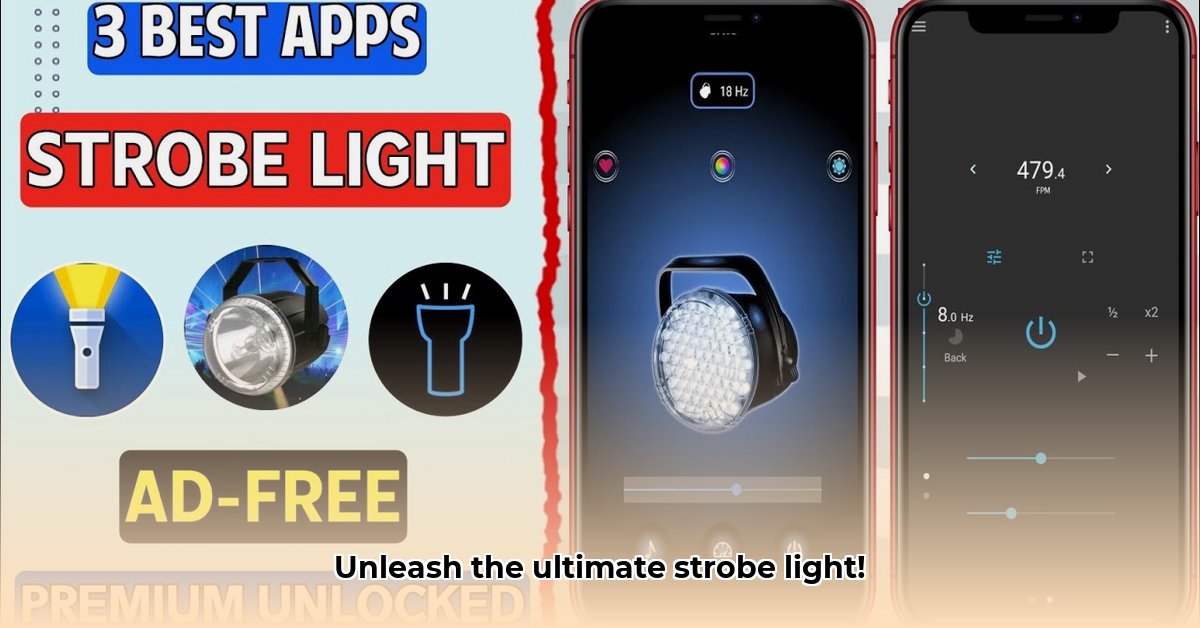
Light Strobe Apps: A Comparative Review of Strobe Light and MoodLight
Choosing a strobe light app requires careful consideration, balancing the desire for visually striking effects with crucial safety concerns. This review compares two popular options, Strobe Light and MoodLight, analyzing their features, ease of use, and most importantly, safety protocols. We'll delve into the technical aspects, explaining how each app utilizes your phone's flash and screen, and how customizable their strobe effects truly are. Ultimately, we aim to equip you with the knowledge to make an informed decision.
Feature Comparison: Power vs. Prudence
Strobe Light prioritizes intensity and customization. Its adjustable intensity and speed settings make it suitable for creating attention-grabbing visuals at parties or events. A dedicated flashlight mode, independent of the strobe function, adds versatility. However, a significant drawback is the absence of a prominent warning about photosensitive epilepsy.
MoodLight, conversely, emphasizes safety. While offering flashing lights, it focuses on controlled, less intense patterns and prominently displays a warning regarding photosensitive epilepsy – a crucial consideration often missing in similar apps. This makes it a safer choice for users concerned about health risks. Does this safer approach compromise the visual impact? We will discuss this further below.
User Experience: A Need for Further Research
Comprehensive data on the user interfaces of both apps remains limited. Further analysis of user reviews and in-depth usability studies is needed to provide a thorough comparison. Initial impressions suggest both apps are relatively intuitive, but a definitive judgment on user-friendliness requires more extensive testing. Which interface offers a smoother, more efficient experience? This question remains open for future investigation.
Safety: A Critical Differentiator
The absence of a clear photosensitive epilepsy warning in Strobe Light presents a considerable safety concern. MoodLight's inclusion of this warning distinguishes it as the safer option. However, users should remain vigilant regarding the potential health impacts of using any strobe light app, regardless of the app’s safety features. Are these apps safe for everyone? The answer is a qualified "no," emphasizing the need for caution.
Technical Limitations: Hardware Constraints
Both apps face inherent limitations imposed by smartphone hardware. Battery life will be affected, with more intense and frequent flashing resulting in faster drainage. The brightness of the phone's flash and screen limits the maximum intensity of the strobe effect, and the maximum flashing frequency may vary depending on your phone model and processing power. These limitations, especially battery drain, require careful consideration. How significant is this battery consumption? An in-depth technical analysis is still needed.
Target Audience: Who Needs What?
Strobe Light likely appeals to a broader audience seeking bright, attention-grabbing effects for events or emergency signaling. MoodLight's design suggests a more niche appeal, targeting individuals needing controlled, less intense strobe effects, possibly for therapeutic purposes or those with visual sensitivities. Which app best fits your specific needs? This depends entirely on your priorities.
Recommendations: Actionable Steps for Stakeholders
The following table outlines recommendations for developers, users, and regulatory bodies:
| Stakeholder | Actionable Steps |
|---|---|
| Strobe Light Developers | Implement a prominent photosensitivity warning; gather user feedback on safety features. |
| MoodLight Developers | Enhance app visibility and explore potential therapeutic applications. |
| Users | Exercise caution; monitor battery life; be aware of photosensitivity risks. |
| Regulatory Bodies | Establish industry standards and guidelines for strobe light app safety. |
Risk Assessment: A Preliminary Evaluation
The following table summarizes a preliminary risk assessment. Further research is needed to refine these estimations.
| Feature | Probability of Failure | Severity | Risk Level | Mitigation |
|---|---|---|---|---|
| Flash Functionality | Low | Minor inconvenience | Low | Regular app updates and thorough testing |
| Screen Strobe | Low | Minor inconvenience | Low | Regular app updates and thorough testing |
| Battery Drain | Medium | App unusability, phone shutdown | Medium | Battery optimization techniques; user warnings |
| Photosensitivity Risk | High (Strobe Light), Medium (MoodLight) | Seizures, discomfort | High (Strobe Light), Medium (MoodLight) | Prominent warnings (especially critical for Strobe Light); intensity limitations. |
The lack of a safety warning in Strobe Light may attract regulatory attention, highlighting the need for clearer safety standards.
Mitigating Photosensitivity Risks: A Practical Guide
Mobile strobe light apps, while offering entertainment and practical uses, pose potential risks, particularly to individuals with photosensitive epilepsy (PSE). Understanding the app's features, intensity, and frequency controls is crucial for safe usage. Gradual adjustments, starting with low intensity, are key to minimizing risks. Always heed manufacturer safety guidelines and consult a medical professional if you have any concerns. Prioritize apps with safety features and read user reviews.
This comparative review provides a framework for making informed decisions about strobe light apps. Remember to prioritize safety and consult a healthcare professional if you have any concerns about photosensitivity.
⭐⭐⭐⭐☆ (4.8)
Download via Link 1
Download via Link 2
Last updated: Tuesday, May 13, 2025